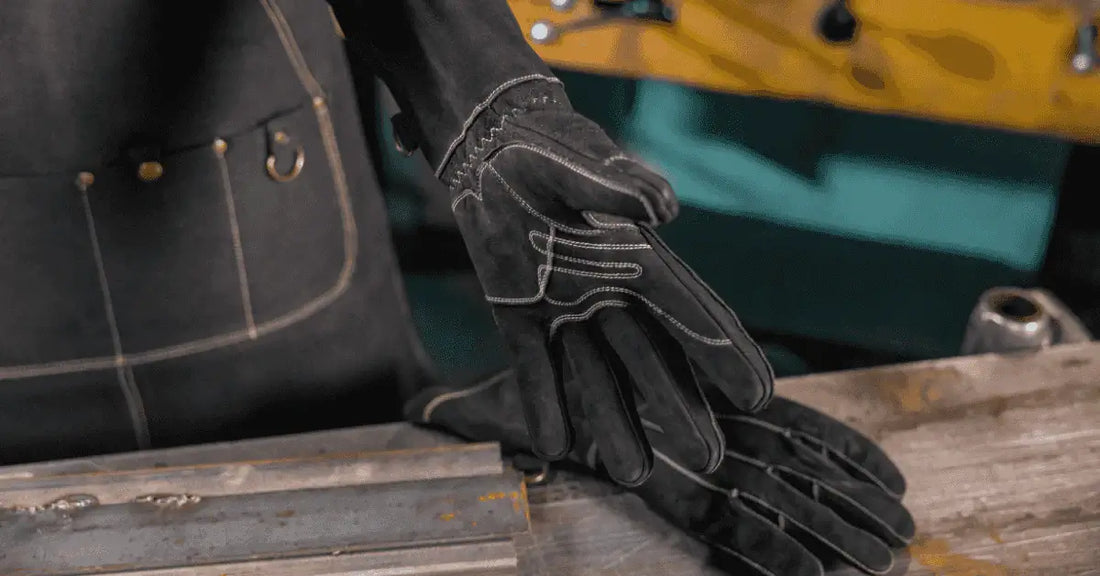When selecting the right material for welding gloves, it's important to recognize that all three of these options—leather, nubuck, and suede—are different forms of leather. The distinction lies in which part of the hide is used and how it is processed. Each material brings unique qualities that impact durability, comfort, and performance. For our gloves, we chose nubuck for its superior balance of strength, flexibility, and grip.
Leather: The Durable Workhorse
Leather, in its traditional full-grain form, is known for being tough and resilient. It’s crafted from the outermost layer of the hide, which retains its natural grain and texture, providing excellent durability and heat resistance. This makes full-grain leather a strong contender for high-performance workwear, including welding gloves, where heat, sparks, and abrasion are everyday challenges.
Leather welding gloves offer excellent protection and longevity but tend to be bulkier and less flexible. Despite this, leather’s robustness is hard to beat when dealing with demanding conditions.
Nubuck: The Perfect Balance (Our Choice)
Nubuck is also made from the outer layer of the hide, just like full-grain leather, but it undergoes a slight sanding process that gives it a soft, velvety texture while maintaining its inherent toughness. This unique finish is what made us choose nubuck for our welding gloves.
We selected nubuck because it strikes the perfect balance between flexibility and protection. The sanding process enhances its grip, making it ideal for welders who need to handle tools with precision, even in slippery conditions. Despite its refined appearance, nubuck retains the durability and heat resistance of full-grain leather, ensuring our gloves provide the protection welders need while offering a more comfortable, supple feel.
Moreover, nubuck is less prone to showing wear and tear compared to suede, which is one of the reasons it’s preferred for heavy-use items like welding gloves. When paired with Kevlar stitching, as we’ve done, nubuck becomes an even more formidable material—providing welders with gloves that are durable, heat-resistant, and comfortable for long hours of work.
Suede: The Soft and Flexible Option
Suede, made from the underside of the hide, offers a soft and pliable texture. While suede is lighter and more flexible, it's generally less durable and less heat-resistant than nubuck or leather. This makes it less suitable for welding gloves, which need to withstand tough conditions.
Suede’s soft texture and increased breathability make it an appealing choice for other products, but in the welding industry, where protection is paramount, suede tends to wear out faster. For tasks that demand flexibility but involve minimal heat or abrasion, suede could be a decent option. However, for welding, where both dexterity and protection are essential, suede falls short in comparison to nubuck.
The Simple Difference Between Leather, Nubuck, and Suede
The difference between these three materials is quite simple: it comes down to which part of the hide is used and how it's treated. Full-grain leather uses the outermost layer, maintaining the natural grain. Nubuck also uses the outer layer, but with a sanded finish, providing a soft texture without compromising strength. Suede, on the other hand, is made from the inner part of the hide, giving it a soft feel but less durability and heat resistance.
Why We Chose Nubuck for Our Welding Gloves
After extensive testing and consideration, we chose nubuck for our welding gloves because it provides the ideal combination of protection, comfort, and performance. Its sanded surface offers a superior grip in all conditions, making it easier to handle welding tools. It is more flexible than full-grain leather, allowing for better dexterity, but still durable enough to resist heat, wear, and tear over time. For welders who demand both safety and comfort, nubuck is the clear choice.
By understanding the simple differences between these materials, it becomes clear why nubuck stands out for welding gloves. Its blend of strength, flexibility, and texture is unmatched, offering welders the protection they need without sacrificing comfort or performance.
